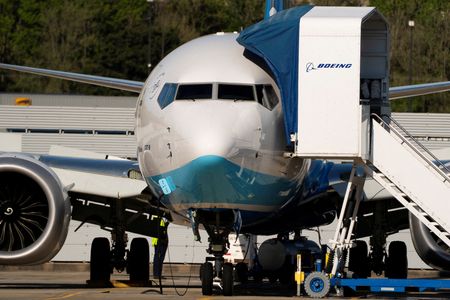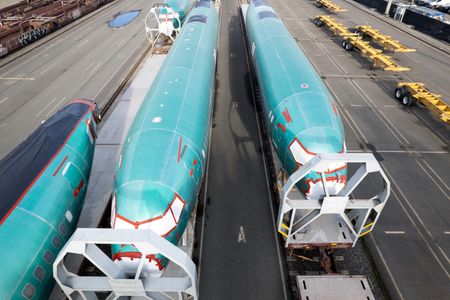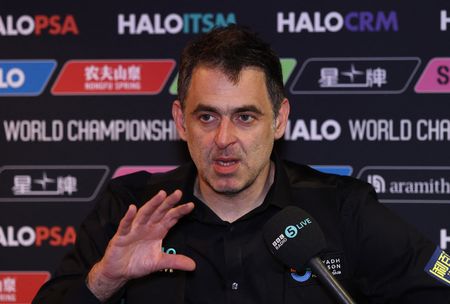By Allison Lampert, Shivansh Tiwary and David Shepardson
(Reuters) -Boeing’s CEO pledged on Wednesday to protect the U.S. planemaker’s recovery from the effects of a U.S.-China trade war, after reporting a smaller-than-expected quarterly loss and higher jet output that boosted shares by 6% in midday trade.
The trade dispute led to the recent return of two Boeing planes destined for China. But CEO Kelly Ortberg said the company has avoided broader damage from tariffs and could redirect jets to other airlines that have been “asking for additional airplanes.”
Boeing planned to deliver about 50 aircraft to customers this year in China. Orders from Chinese carriers represent about 10% of the planemaker’s commercial backlog.
“I feel really good about our overall plan for the year, even though I expect the China situation will take away some of the headroom we’ve built with our strong first quarter deliveries,” Ortberg told analysts.
The United States and China, the globe’s two largest economies, have each imposed duties exceeding 100% on the other.
Reuters reported the Trump administration is considering lowering tariffs on Chinese imports, pending talks with Beijing, citing a source familiar with the matter.
Ortberg said China is the only country where Boeing has a problem with aircraft deliveries due to tariffs, but the planemaker is also watching for potential retaliatory duties from Europe, and is talking with the White House.
“I don’t think a day goes by where we aren’t engaged with someone in the administration, including … cabinet secretaries and up to POTUS himself,” Ortberg said, referring to President Donald Trump.
While Boeing is paying a 10% U.S. tariff on imported parts from countries such as Japan and Italy, the company expects to recover those costs as the components are used in aircraft that it subsequently exports.
The trade war poses a fresh challenge to the planemaker, which wrestled in 2024 with internal quality problems and a crippling strike that shuttered most of its aircraft production late last year.
RISING OUTPUT
Boeing now wants to roughly double output of its top-selling 737 MAX plane from its January level to a regulator-capped 38 per month by the end of this year.
Ortberg, who took the planemaker’s helm last year promising to cautiously grow output, told analysts Boeing is producing 737s at a monthly rate in the low 30s and expects to get to the 38 per month cap over the next few months.
“The key to cash generation will be continued progress on the 737 MAX ramp,” Ortberg said.
Ortberg, who referred to 2025 as Boeing’s “turnaround year” in a letter to employees on Wednesday, said the company also hopes to conduct more flights of its troubled Starliner space program this year.
Free cash flow usage, a metric closely watched by investors, improved during the quarter to negative $2.3 billion, beating analysts’ expectations of negative $3.6 billion on average, according to data compiled by LSEG. Chief Financial Officer Brian West told analysts free cash flow usage would be similar in the second quarter to usage during the first quarter.
Ortberg reiterated a company target of positive free cash flow in the second half of the year as the company focuses on reducing debt and selling non-core assets.
On Tuesday, Boeing announced the sale of portions of its Digital Aviation Solutions business, including navigation unit Jeppesen, for $10.55 billion.
Boeing’s defense unit returned to profitability after three consecutive quarters of losses, reporting operating earnings of $155 million – up slightly from $151 million a year earlier.
In March, Boeing was awarded a contract to build the U.S. Air Force’s most sophisticated fighter jet yet, the F-47.
The planemaker reported an adjusted loss of 49 cents per share during the first quarter, compared with a loss of $1.13 per share a year ago. Analysts were expecting the company to report an adjusted loss of $1.29 per share, according to data compiled by LSEG.
Vertical Research analyst Rob Stallard called the results “relatively boring” compared with other quarters.
“While burning through over $2 billion of cash is hardly ‘good,’ consensus had been expecting worse,” he said in a note to clients. “However, all eyes are on the future.”
(Reporting By Allison Lampert in Montreal and Shivansh Tiwary in Bengaluru; Editing by Arun Koyyur and Rod Nickel)











